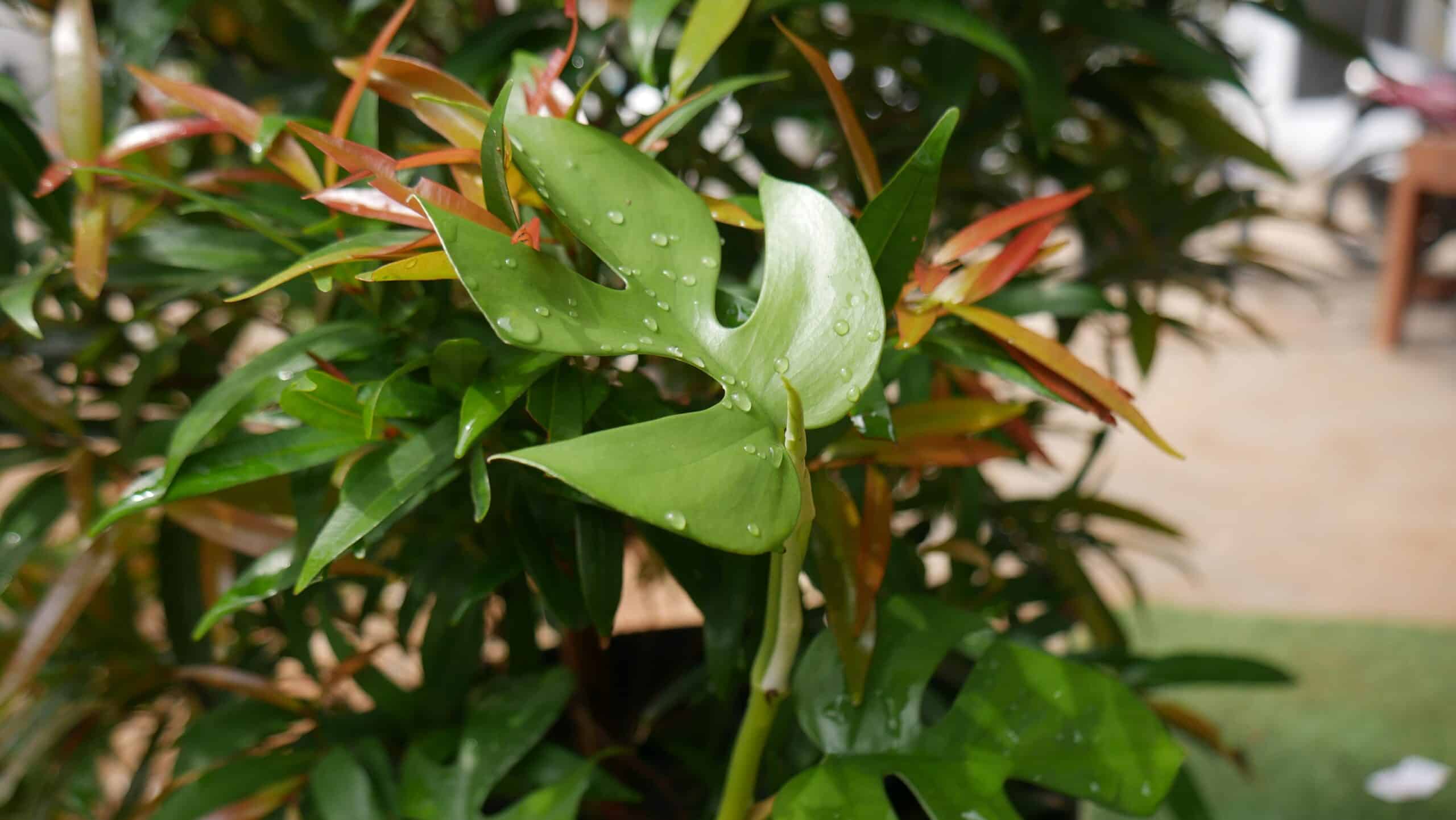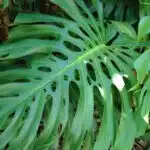If you’re looking for an easy-to-care-for houseplant that will bring a tropical flair to any space, look no further than the Mini Monstera. This fast-growing plant not only looks beautiful but is also incredibly low maintenance and can easily be grown indoors. But what exactly do you need to know before embarking on your Mini Monstera growing journey?
The first step in growing this unique houseplant is understanding its needs. Mini Monsteras require bright, indirect sunlight and warm temperatures, so make sure the place you choose to display it fits these criteria. In addition, you’ll want to provide plenty of humidity and water regularly. Lastly, be sure to use a potting soil that has good drainage and aeration qualities.
Once all of these basics are taken care of, it’s time for the fun part – watching your Mini Monstera grow! With proper care and attention, this plant can reach up to 6 feet tall and produce attractive foliage with unique leaves in a variety of shapes and sizes. Continue reading for more helpful tips and advice about how to grow a healthy Mini Monstera in your home or office!
Understanding The Basics Of Mini Monstera
Mini monstera (Rhaphidophora tetrasperma), also known as the “Fenestration Philodendron” or “Ginny,” is an evergreen, vining plant that is easy to grow. It has striking foliage and bold texture, with its leaves having unique, split lobes and deep indentions. Given the right conditions, this mini monstera can thrive both indoors and outdoors.
Before you start growing a mini monstera, it’s important to understand how best to take care of it. This includes knowing when to water it, what kind of light it needs, and how often to fertilize it. When watering your mini monstera, make sure not to overdo it—the soil should be kept moist but not soggy. Place your mini monstera in bright indirect light for optimal growth; direct sunlight can cause the leaves to burn. Lastly, fertilize your plant every 3-4 months with a balanced fertilizer designed for houseplants.
Taking a few simple steps can ensure that your mini monstera stays healthy and grows happily for years to come! With proper care and attention, you’ll be able to enjoy its lush foliage for many seasons; now all that’s left is selecting a pot for planting.
Selecting A Pot For Planting
Mini monstera, or Rhaphidophora tetrasperma, is a popular houseplant that can be easily grown indoors. According to the American Society for Horticulture Science, it is estimated that over 10 million households in the US include one of these plants in their collection. This makes selecting the right pot for planting an important step in ensuring your mini monstera thrives.
When choosing a pot, look for something with good drainage such as terracotta or ceramic. Make sure there are plenty of drainage holes to allow excess water to escape from the soil. Ensure the pot is wide enough so that roots will have plenty of room to spread out, and select one with a depth about six inches deep. Additionally, there should be a plate or saucer underneath the pot to prevent water from spilling onto furniture or floors.
Finally, take into consideration how much natural light your mini monstera will receive when deciding on size and material of the pot. Larger containers are better suited for rooms with lots of natural light while smaller pots can work well in medium-light areas like offices and bedrooms. Clay pots tend to absorb more heat than plastic which can be beneficial during cold winter months. With the right potting container selected and prepared, you can move onto prepping the soil for your mini monstera’s new home!
Preparing The Soil
Preparing the soil is an important step in ensuring that your mini monstera will thrive. It’s vital to choose the right type of soil and mix it with other ingredients, such as fertilizer and compost, to create a balanced environment for your plant. The most important thing is to make sure that the soil drains well; if it’s too soggy, the roots may rot. To prepare the soil, start by adding two parts potting mix to one part perlite or vermiculite. This will ensure that there is enough oxygen in the soil for the roots to breathe and help prevent root rot from occurring.
You can then add some organic matter like compost or aged manure to give your plant extra nutrition. Finally, you’ll want to add some slow-release fertilizer like fish emulsion or blood meal. This will provide essential nutrients that your mini monstera needs for healthy growth over time.
Mix all these components together until you have a well-balanced blend that’s moist but not overly wet. Doing this will help ensure that your mini monstera receives all the necessary elements it needs for healthy growth. With proper preparation of the soil, your plant should be ready for planting and caring for!
Planting And Caring For Mini Monstera
When it comes to planting mini monstera, you’ll need to make sure the soil is moist, but not soggy. You should also place the plant in a pot that’s just slightly larger than its root ball. After planting, water the potting soil until it’s evenly moist and then let the top few inches of soil dry out before watering again.
To properly care for your mini monstera, make sure to keep it in an area with bright indirect light and keep the temperature between 62 and 80 degrees Fahrenheit. It’s important to note that these plants do not like direct sunlight and should be kept away from drafts or air conditioners. Additionally, you should fertilize your mini monstera every two weeks during its growing season with a balanced liquid fertilizer diluted to half strength.
In terms of humidity levels, mini monstera prefers high humidity levels of 70% or higher. If you live in a dry climate, consider misting your plant regularly or setting a humidifier nearby. With proper care and attention this tropical houseplant can thrive in your home for years!
Water Requirements For Mini Monstera
Water is essential for any plant, and mini monstera is no exception. As the old adage goes, “Give a man a fish and feed him for a day; teach a man to fish and feed him for a lifetime”. When it comes to taking care of this unique plant, you need to understand how much water it needs in order to keep it healthy.
The most important thing when watering mini monsteras is consistency. During its growing season, they should be watered regularly but not heavily – about once every 7-10 days depending on humidity levels and soil conditions. In the winter months, reduce the frequency of watering since the plant won’t be actively growing – only water if the soil feels dry.
It’s also important to note that mini monsteras like their roots to stay moist but not soggy. To ensure this, use well-draining soil that can hold some moisture without becoming oversaturated. Also, make sure your pot has good drainage holes so excess water can escape easily. With these tips in mind, you can give your mini monstera just enough water each week for optimal growth!
With proper hydration taken care of, next up is selecting the right sunlight…
Selecting The Right Sunlight
Once you’ve gotten your mini monstera, the next step is to select the right sunlight for it. These plants prefer bright, indirect light and can even tolerate some direct sun in the morning or late afternoon. If you don’t have access to a lot of natural light, you can supplement with a grow light. However, make sure you don’t place your plant too close to the bulb because this could lead to sunburn.
When it comes to watering, mini monstera need moist soil but not soggy. You should water them once or twice a week depending on your climate and how much sunlight they’re receiving. If your climate is particularly dry, then you may need to water more often. On the other hand, if it’s especially humid and rainy, then you’ll likely only need to water once a week or so.
It’s also important that you use filtered or distilled water when watering your mini monstera. This helps prevent mineral buildup in the soil which can be damaging for these plants over time. With that said, now that we’ve covered selecting the right sunlight for mini monstera let’s move onto feeding and fertilizing them for optimal growth!
Feeding And Fertilizing Mini Monstera
Similar to a chef preparing a meal, providing the right nutrients to a mini monstera is key to keeping it healthy. Fertilizing and feeding your mini Monstera are essential parts of its growth cycle. To ensure that your plant gets the best care possible, it’s important to use the right techniques and products.
When fertilizing and feeding your mini Monstera, use an all-purpose fertilizer diluted up to half strength throughout the growing season and give them a full-strength dose in early spring. If you prefer organic methods for your feeding needs, use composted manure or compost tea as an alternative solution. Be sure not to overfeed your plants, as this can cause root burn and harm their overall health.
Watering is also essential for keeping your mini Monstera looking its best. Make sure you’re giving them enough water but not too much; soggy soil will cause root rot and destroy your plant’s roots. Aim for moist soil that drains quickly, so rainwater is usually enough without having to supplement with additional waterings over time.
Providing appropriate humidity levels is another crucial part of caring for a mini Monstera successfully. Humidity should be kept at around 50% during the summer months, while it can be lower during the winter season when growth slows down.
Appropriate Humidity Levels
When it comes to humidity, Mini Monsteras prefer higher levels of moisture in the air. To maintain proper humidity levels, a humidifier should be used in the room where the plant is kept. This will help keep the leaves from drying out and help them to stay healthy. Additionally, if you have other plants nearby that produce a lot of moisture, this can also help create a more humid environment for your Mini Monstera.
It’s important to remember that too much humidity can be just as bad as not enough. Too much moisture can cause fungal diseases and mold growth in the soil. It’s best to keep an eye on your plant’s leaves and take action if they start appearing wet or droopy. If necessary, you can use a dehumidifier to reduce the amount of moisture in the air surrounding your plant.
No matter what, it’s important to make sure that your Mini Monstera is getting enough humidity without being too saturated with water. With regular monitoring and proper care, your Mini Monstera should thrive in its new home!
Pruning And Repotting Mini Monstera
Pruning and repotting mini monstera can be a tricky task. It’s important to know when to prune so that you don’t damage the plant and also when to repot it into a larger container. First, let’s look at pruning. Pruning helps the plant maintain a healthy shape and size, as well as encourages new growth. When pruning, make sure not to remove too much of the stem or leaves, as this could lead to damaged roots. Also, try not to prune more than one-third of the plant at one time.
When it comes time for repotting, you’ll want to start with a larger pot than what your mini monstera is currently in. A pot with good drainage holes is also important – this will help ensure that excess water doesn’t get trapped in the soil and cause root rot. Make sure you use fresh potting soil for repotting; an all-purpose mix should do just fine. Finally, remember not to over-water your mini monstera during transplantation – this could cause damage to its roots.
Repotting your mini monstera once every two years should be enough; however, if you notice signs of root rot or other problems before then, it may be necessary to repot sooner than two years. With proper care and attention, your mini monstera can thrive in its new home! Moving on from here, we’ll discuss how to control pests and diseases in these plants.
Controlling Pests And Diseases
Controlling pests and diseases is an important part of caring for a Mini Monstera. While it can be tricky to keep your plant in tip-top shape, there are several ways to control pests and prevent diseases from occurring. Juxtaposed against the excitement of growing a Mini Monstera, the reality is that they require extra care when it comes to pest control.
The most common pests you’ll find on Mini Monsteras are mealybugs and spider mites, which can be treated with either insecticidal soap or neem oil. Be sure to treat both sides of the leaves, as well as the stems and any crevices in the potting soil where pests may hide. Additionally, you should use a damp cloth or cotton swab soaked in rubbing alcohol to remove any remaining bugs after treatment.
If you notice signs of disease, such as wilting leaves or discoloration, it’s best to immediately isolate the affected plant from other houseplants. Treating with fungicides and adjusting your watering practices can help minimize further damage and help protect other plants from infection.
With proper care and attention, a Mini Monstera will remain healthy for many years to come!
Propagating Mini Monstera
Growing mini monstera is so much fun! You get to play mad scientist and create cute little plants for your home or garden. But, do you know the best part? Propagating them. Yes, that’s right – you can make more of these magical little plants from the ones you already have. Let me tell ya all about it!
Propagating mini monstera is a great way to increase your collection without having to buy new plants. It’s also an easy way to share your plant babies with friends and family. So how do we do it? Well, the best method is to use stem cuttings with at least two leaves attached. Once you’ve got your cutting, put it in a pot filled with rich soil mixed with some perlite for drainage and water it thoroughly. Place the pot in an area with plenty of bright, indirect sunlight and keep the soil moist but not soggy. In a few weeks, you should start to see roots growing!
Once your mini monstera has grown some roots, it’s time for transplanting into its own pot where it can grow big and strong! Make sure the soil is well draining and lightly fertilize every couple of weeks for optimal growth. With proper care, you’ll have a thriving mini monstera in no time! Now let’s talk about overwintering these little guys…
Overwintering Mini Monstera
To ensure your mini monstera plant stays healthy year-round, it’s important to know how to overwinter it. This process consists of adjusting the light and temperature levels, as well as moisture levels.
For starters, you’ll want to reduce the amount of light your mini monstera is receiving by moving it away from direct sunlight or fluorescent lights. You should also lower the temperature in which the plant is kept; aim for temperatures between 50°F and 55°F at night. Additionally, cut back on waterings during this time—only watering when the soil feels dry.
It’s equally important to monitor the humidity levels around your mini monstera. To maintain ideal levels, misting the leaves every few days and using a pebble tray should do the trick. With these measures in place, your mini monstera should be ready for a successful winter season! Now let’s take a look at some troubleshooting tips that may come in handy.
Troubleshooting Tips
Troubleshooting tips for your mini monstera can be a tricky endeavor. It may feel like a labyrinth at times, but with the right guidance you can easily navigate it. Figuratively speaking, troubleshooting is like finding the missing piece of a puzzle – without it, the whole thing won’t quite fit together.
From improper watering to inadequate light, there are many things that can potentially go wrong when growing mini monstera. To prevent these issues from occurring in the first place, make sure to always read up on proper care and maintenance guidelines before getting started. Additionally, keep an eye out for any signs of distress that could indicate something is amiss.
If problems do arise, take action immediately by adjusting your care routine as needed and addressing any underlying factors that could be causing harm to your plant. A little extra TLC now can help avoid bigger problems down the road! With this knowledge in hand, you’ll be well-equipped to give your mini monstera the best chance of thriving – no matter what life throws its way.
Tips For Keeping Mini Monstera Healthy
Tending to a mini monstera is like tending to a baby – with the right environment and care, it can thrive and flourish. Like any living thing, it needs attention, and understanding its needs is key to keeping it healthy. To this end, here are some tips for keeping your mini monstera happy and vibrant.
Like a tiny sun-worshiper, mini monsteras need plenty of bright light but not direct sunlight. This means placing them near a window that gets plenty of indirect sunlight during the day. Additionally, they should be given weekly feedings of diluted liquid fertilizer to keep them nourished and hydrated.
Lastly, mini monsteras should be watered regularly but not excessively – about once or twice a week depending on the season and climate. Be sure to let the top inch or two of soil dry out between waterings as overwatering can lead to root rot. With these considerations in mind, your mini monstera will stay healthy and vibrant for years to come!
Sources For Buying Mini Monstera
Mini monstera is like a precious gem, adding beauty and life to any home. With proper care, this exotic looking plant can thrive in your own space! When it comes to buying mini monstera, there are several sources available. This article will explore the different places you can find these plants so you can start growing one of your own.
If you’re looking for an easy way to get started with mini monstera, online retailers are a great option. You can purchase them directly from the nursery and have it shipped right to your door. Plus, many online stores offer discounts for bulk purchases or special promotions throughout the year. Not only does this save time and money, but it also allows you to compare prices and quality between different nurseries before making your final selection.
Finally, local garden centers are another excellent option for purchasing mini monstera plants. Here, you’ll be able to see the plant up close and personal, ensuring that you get exactly what you need. Additionally, local staff members may be able to provide helpful tips on how best to care for your new plant friend once it arrives at home. With their expertise and experience, they will help ensure that your mini monstera continues to flourish over time!
Frequently Asked Questions
How Often Should I Fertilize Mini Monstera?
Fertilizing Mini Monstera is an important part of their care, as it helps them grow strong and healthy. It’s recommended that you fertilize the plant once every two weeks using a balanced fertilizer with equal parts nitrogen, phosphorus, and potassium. If you’re using a liquid fertilizer, dilute it to half strength before applying. Make sure to avoid over-fertilizing, though, as that can cause damage to the roots and leaves.
When fertilizing your Mini Monstera, it’s best to use a balanced fertilizer that has equal parts of nitrogen, phosphorus, and potassium. You’ll also want to make sure to water the soil thoroughly before and after fertilizing so that all of the nutrients have time to absorb into the soil. Additionally, you’ll want to be sure not to apply too much fertilizer; this could lead to root or leaf burn.
To ensure your Mini Monstera is getting enough nutrients for optimal growth and health, it’s important to fertilize regularly. Stick with fertilizing once every two weeks at half strength with a balanced fertilizer for best results. With proper care and nutrition, your plant should grow strong and healthy in no time!
When Is The Best Time To Repot Mini Monstera?
The mini monstera, with its striking foliage and unique shape, is an eye-catching addition to any home. But like any other plant, it requires a little bit of care in order to thrive. One important part of keeping your mini monstera healthy is repotting it at the right time.
Repotting your mini monstera is like giving it a fresh start – a chance to grow into a bigger and better version of itself. The best time to repot your plant is when you notice that the roots have outgrown the pot and are starting to crowd the soil. This usually happens once every two or three years, depending on how quickly it grows.
When you’re ready to repot your mini monstera, make sure that you use fresh potting soil and that the new pot has enough room for growth. It’s also important to take care not to damage the roots as you transfer it from one pot to another; by doing so, you’ll ensure that your plant continues to be happy and healthy.
How Big Can Mini Monstera Get?
Mini monstera, otherwise known as rhaphidophora tetrasperma, is a popular houseplant that can be found in many homes. It’s small size and easy care make it an ideal choice for those looking to start their own indoor garden. But how much bigger can these mini monsters get?
Much like other vine-like plants, mini monstera can grow quite tall – up to eight feet – if given the right conditions. However, with proper pruning and maintenance, they can be kept at a more manageable size. One of the benefits of owning this plant is that you are in control of its growth rate; allowing you to keep it small and compact or let it reach its full potential.
The best way to ensure your mini monstera is getting all the nutrients it needs is by regularly repotting it into larger containers. This process not only provides it with extra room to spread out and thrive, but also gives you the opportunity to inspect its roots and look for signs of distress or disease. With enough love and care you will have a lush mini monstera that will bring life into any room!
What Type Of Soil Should I Use For Mini Monstera?
Mini monstera, also known as Rhaphidophora tetrasperma, is a stunning and unique houseplant. When it comes to growing this special plant, you’ll want to make sure you have the right soil to ensure success. So, what type of soil should you use for mini monstera?
Well, the key is to create a light and airy mix that provides plenty of drainage. A good starting point would be to mix two parts potting soil with one part perlite or coarse sand – this will provide the ideal environment for your mini monstera’s roots. You can also add in some compost or other organic matter for extra nutrients. It may sound like a daunting task, but don’t worry – it’s really quite simple!
Once your soil is ready, you’ll be on your way to growing mini monstera with ease. All you need now is some patience and dedication – and before you know it, you’ll have a healthy and vibrant mini monstera thriving in your home! With the right care and attention, nothing can stop you from achieving success with this beautiful houseplant.
How Do I Propagate Mini Monstera?
Making a mini monstera (Rhaphidophora tetrasperma) thrive in your home is a great way to add an exotic touch. But before you can enjoy the beauty of these stunning houseplants, one must first learn how to propagate them. Thankfully, propagating mini monstera is fairly easy and straightforward!
Let’s start by looking at the various ways one can propagate this unique plant. One of the most popular methods is stem cutting, where you take a healthy stem from an existing mini monstera and remove its leaves. Then, the stem is placed in soil or water until it develops new roots. Another successful propagation method is division, which involves carefully separating the plant into two or more parts without damaging its roots too much. Lastly, air layering is also possible with mini monsteras by removing any leaves on a certain part of the stem and wrapping it in wet sphagnum moss before burying it in soil or water.
Whichever propagation method you choose for your mini monstera, make sure to keep up with regular watering and fertilizing for best results. Additionally, provide your plants with bright but indirect sunlight in order to help them grow strong and healthy. With time and patience, you’ll soon have a thriving mini monstera that can bring life and beauty into your home!
Conclusion
Monstera, the mini houseplant that’s taken the interior design world by storm, is a surprisingly simple plant to look after. With just a few basic requirements and occasional repotting, you can easily keep your little Monstera looking its best. All you need to do is give it plenty of bright light, water it regularly and fertilize it every few weeks. Make sure you use the right type of soil and pots for optimal growth – if you’re in doubt, err on the side of caution.
With just these few steps, your little Monstera will stay happy and healthy for years to come! And don’t forget – if you ever want to add another one to your collection, essentially all you need to do is take a cutting from an existing plant and stick it in some soil. It’s really as easy as that!
So if you’ve been looking for an easy-care plant that will bring life into your home without taking too much effort on your part – look no further than Mini Monstera! Its petite size makes it perfect for small spaces, so even if you live in a tiny apartment or dorm room, this happy houseplant will fit right in!





























